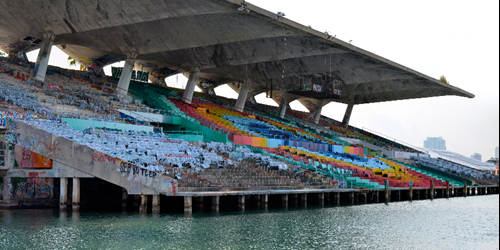
For Immediate Release
Tuesday, April 17, 2018
Contact: Sarah Revell
850.245.6522
[email protected]
Secretary Detzner Announces the Designation of Miami Marine Stadium on the National Register of Historic Places
TALLAHASSEE, FLA. –
Secretary of State Ken Detzner announced today that Miami Marine Stadium has been listed on the National Park Service’s National Register of Historic Places.
“The Miami Marine Stadium is one of the state of Florida’s most unique architectural and historic resources,” said Secretary Detzner. “As an ambitious example of mid-century Modernist architecture by a Cuban-American architect, Miami Marine Stadium represents the multi-cultural influences evolving in the city of Miami during the 1960s.”

Miami Marine Stadium, located on Virginia Key, is a significant example of Modernist architecture characteristic of mid-1960s Miami. An example of the Brutalist style of architecture, the building was designed for public use and enjoyment. The stadium was the result of a partnership between Cuban-American architect Hilario Candela and engineer Jack Meyer. After fleeing Cuba in the wake of the Cuban Revolution, Candela studied architecture at Georgia Tech and then established himself in Miami as an architect for a notable local architecture firm. One of his early projects, Miami Marine Stadium is his most iconic work from a decades-long career.
Candela’s design for Miami Marine Stadium is intended to communicate to a viewer or visitor its purpose, both as a waterside entertainment venue and as a monument to Miami’s mid-century aspirations. Constructed primarily of concrete, the structure’s design is evocative of its waterfront location with shapes that reflect nautical themes. Candela described the stadium as “an architecture for that place where the land and the sea kiss.” A remarkable work of engineering, the structure’s large nontrussed cantilevered roof, which at the time was the longest in the world, demonstrates the mid-century aesthetic of attempting to break barriers and prove the expanding possibilities of modern architecture. Miami Marine Stadium is a triumphant example of monumental Miami architecture.
Miami Marine Stadium hosted sporting and entertainment events, including powerboat races, concerts, boxing matches, religious ceremonies, and political events for almost three decades, until it was closed in the wake of Hurricane Andrew in 1992. Miami Marine Stadium has received recognition from the World Monuments Fund, the National Trust for Historic Preservation, DoCoMoMo, and the Getty Foundation as an outstanding example of mid-century design.
# # #
About the National Register of Historic Places
The National Register of Historic Places is a list maintained by the National Park Service which includes historical or archaeological properties including buildings, structures, sites, objects, and districts, that are considered worthy of preservation because of their local, statewide and/or national significance. Nominations for properties in Florida are submitted to the National Park Service through the Florida Department of State’s Division of Historical Resources. Florida has over 1,700 listings on the National Register, including 295 historic districts and 175 archaeological sites. There are more than 50,000 sites contributing to the National Register in Florida. For more information, visit flheritage.com/preservation/national-register. For more information about the National Register of Historic Places program administered by the National Park Service, visit nps.gov/nr.
About the Florida Department of State’s Bureau of Historic Preservation
The Bureau of Historic Preservation (BHP) conducts historic preservation programs aimed at identifying, evaluating, preserving and interpreting the historic and cultural resources of the state. The Bureau manages the Florida Main Street Program, and under federal and state laws, oversees the National Register of Historic Places program for Florida, maintains an inventory of the state's historical resources in the Florida Master Site File, assists applicants in federal tax benefit and local government ad valorem tax relief programs for historic buildings, and reviews the impact that development projects may have on significant historic resources. For more information, visit flheritage.com/preservation.

